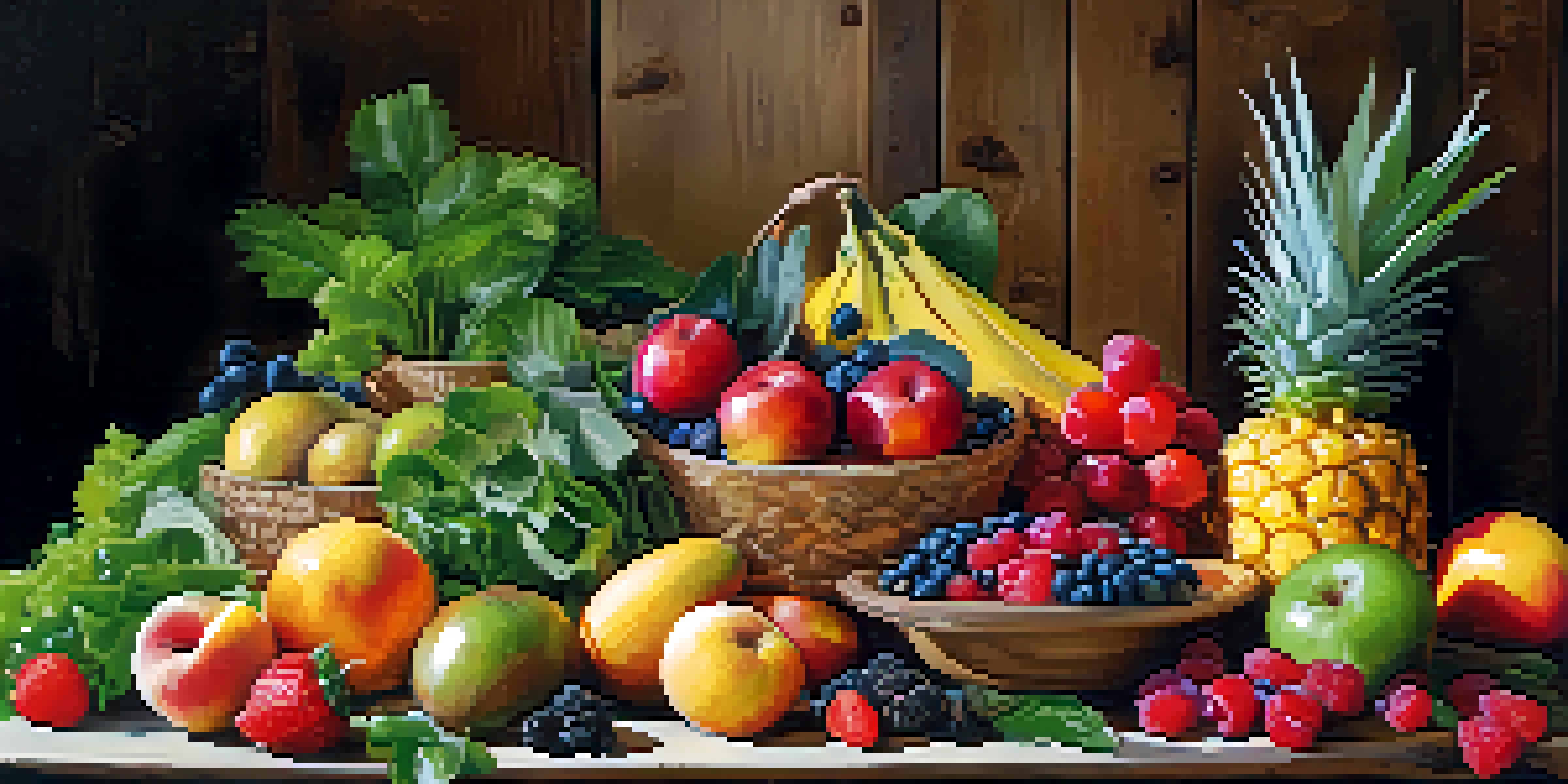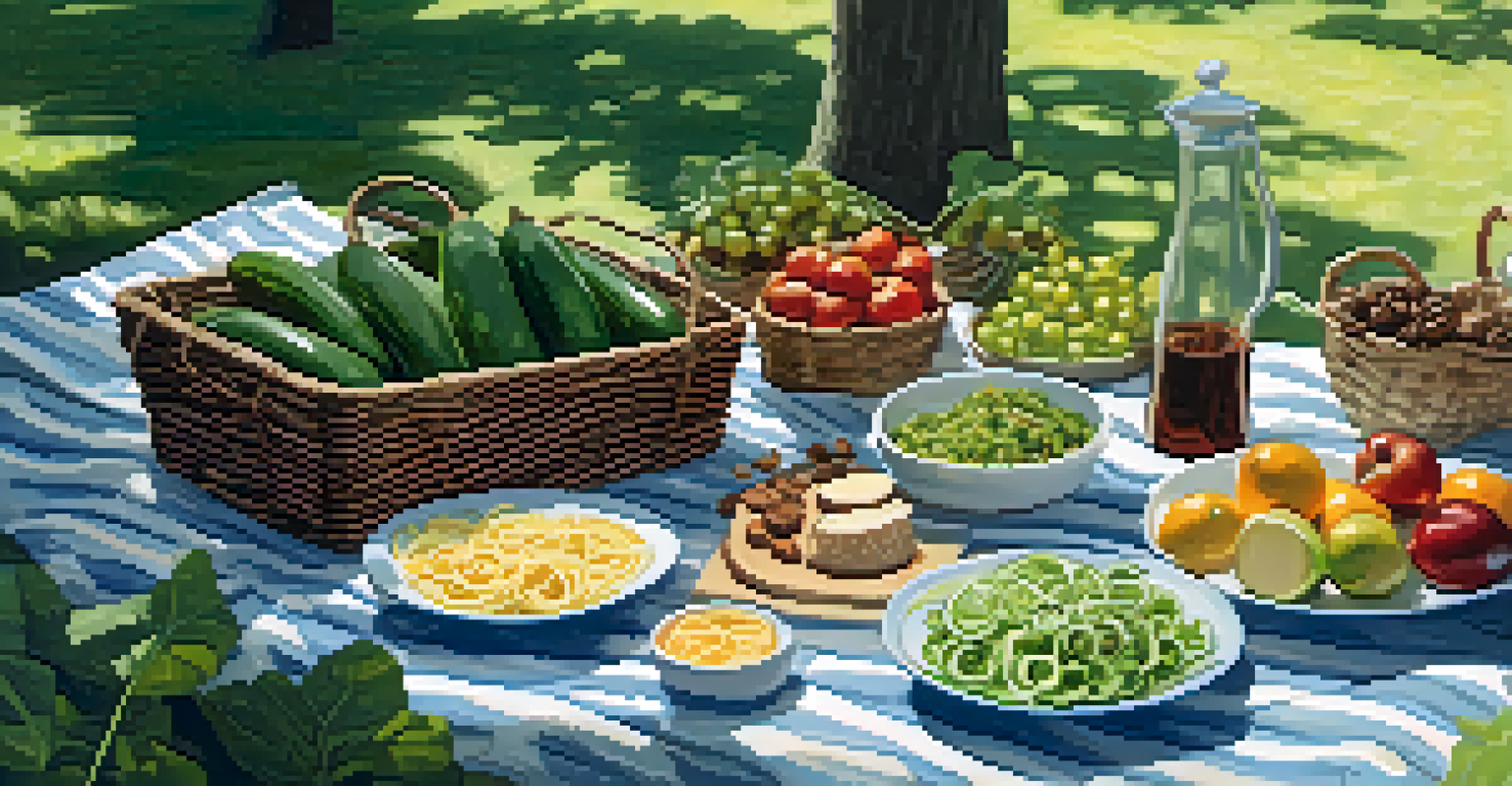Understanding the Raw Food Lifestyle: Principles and Practices

What is the Raw Food Lifestyle and Its Core Beliefs?
The raw food lifestyle centers around consuming unprocessed and uncooked foods, primarily fruits, vegetables, nuts, seeds, and sprouted grains. Proponents believe that cooking can destroy vital nutrients and enzymes that are essential for optimal health. By adhering to this diet, individuals aim to reconnect with nature and enjoy the health benefits that come from eating fresh, whole foods.
Let food be thy medicine and medicine be thy food.
At its core, this lifestyle promotes the idea that food should be as close to its natural state as possible. Think of it as eating like our ancestors did—relying on nature's bounty without the interference of modern food processing. This approach not only emphasizes health but also encourages a more holistic view of well-being, integrating physical, emotional, and spiritual aspects.
Many raw food enthusiasts also advocate for sustainable eating practices, which can lead to a reduced environmental footprint. By choosing organic and locally sourced produce, they support sustainable agriculture and minimize the impact of food transportation. Ultimately, the raw food lifestyle is about nourishing the body while respecting the earth.
The Health Benefits of a Raw Food Diet
Adopting a raw food diet can lead to numerous health benefits, including weight loss, improved digestion, and increased energy levels. Since raw foods are typically low in calories but high in nutrients, they can help individuals maintain a healthy weight without feeling deprived. This is akin to filling up on delicious, nutrient-dense foods rather than empty calories from processed snacks.

Moreover, raw foods are rich in enzymes that aid in digestion. Cooking foods often destroys these enzymes, making it harder for our bodies to break down and absorb nutrients. By eating raw, many people report enhanced digestion and a reduction in bloating or discomfort after meals, making it an appealing choice for those with digestive issues.
Raw Food Diet: Health Benefits Abound
Adopting a raw food diet can enhance weight loss, improve digestion, and boost energy levels through nutrient-rich, unprocessed foods.
In addition to physical benefits, many raw food followers experience improved mental clarity and mood. The influx of vitamins, minerals, and antioxidants from fresh produce can boost brain function and elevate overall emotional well-being. It's like giving your brain a refreshing drink of clean water—suddenly, everything feels sharper and clearer.
Common Misconceptions About Raw Food Diets
One common misconception about the raw food lifestyle is that it’s restrictive and lacks variety. While it's true that the diet primarily consists of raw fruits and vegetables, there are countless ways to prepare and combine these ingredients. For instance, one can enjoy raw smoothies, salads, or even raw desserts made from nuts and natural sweeteners, proving that this lifestyle can be as diverse as cooked diets.
You are what you eat, so don’t be fast, cheap, easy, or fake.
Another myth is that all raw foods are healthy. While many raw foods are packed with nutrients, some can be high in sugars or fats, like certain fruits or nuts. It's essential to maintain balance and moderation even within a raw food framework to avoid potential pitfalls, just as one would in any other dietary approach.
Lastly, some believe that a raw food diet lacks sufficient protein. However, there are plenty of raw sources of protein, including nuts, seeds, and legumes. By incorporating a variety of these foods, raw foodists can easily meet their protein needs while enjoying delicious meals that nourish their bodies.
Tips for Transitioning to a Raw Food Diet
Transitioning to a raw food diet can be exciting yet challenging. Start by gradually incorporating more raw foods into your meals, perhaps by adding a salad or smoothie to your daily routine. This method allows your palate to adjust while minimizing feelings of deprivation, making the transition smoother and more enjoyable.
Experimenting with different recipes can also make the transition appealing. There are countless raw food cookbooks and online resources filled with creative ideas that can inspire you to try new things. From raw pasta made from zucchini to delicious energy bites made from nuts and dates, you'll discover that raw food can be both tasty and satisfying.
Common Misconceptions Debunked
Many believe the raw food lifestyle is restrictive, but it offers a diverse array of meals and snacks that can satisfy various tastes.
Lastly, finding a supportive community can make a world of difference. Joining online forums, social media groups, or local meetups can provide motivation and encouragement as you embrace this new lifestyle. Sharing recipes, tips, and experiences with others can really enhance your journey into the world of raw foods.
Essential Foods for a Raw Food Pantry
Building a raw food pantry requires stocking up on a variety of fresh, whole ingredients. Start with a colorful array of fruits and vegetables, as these will form the foundation of your meals. Staples like leafy greens, avocados, berries, and bananas are not only nutritious but also versatile for various recipes.
Nuts and seeds are another essential category to include, as they provide healthy fats and protein. Think almonds, walnuts, chia seeds, and hemp seeds—these ingredients can be used in smoothies, salads, or as snacks. They’re like the secret weapons of the raw food pantry, adding texture and flavor to your dishes.
Additionally, don't forget about superfoods and natural seasonings. Items like spirulina, nutritional yeast, and raw cacao can elevate your meals, while herbs and spices can enhance flavors without the need for cooking. With the right pantry, you'll have everything you need to whip up delicious, nourishing raw meals.
Overcoming Challenges in a Raw Food Lifestyle
While the raw food lifestyle has many benefits, it can also present unique challenges. One common hurdle is finding suitable dining options when eating out. Many traditional restaurants may not offer raw dishes, making it essential to research and seek out eateries that accommodate this diet. It can feel like a treasure hunt, but discovering local raw food cafes can be a rewarding adventure.
Another challenge is dealing with cravings for cooked foods. It’s natural to miss the comfort of certain favorite meals. To combat this, try recreating your beloved dishes using raw ingredients. For example, you can make raw pizza using a dehydrated crust topped with fresh veggies and a cashew cheese. This way, you can satisfy your cravings while staying true to your raw food principles.
Sustaining a Raw Food Lifestyle
Long-term success in a raw food diet involves listening to your body, making necessary adjustments, and staying connected with the community.
Lastly, social situations can become tricky when embracing a raw food lifestyle. Attending gatherings or parties where food is served can be a test of willpower. Preparing and bringing your own raw dishes can help you navigate these situations while sharing your passion for raw foods with others.
Sustaining the Raw Food Lifestyle Long-Term
Sustaining a raw food lifestyle over the long term involves understanding your body’s needs and making adjustments as necessary. It's crucial to listen to your body and ensure you're getting a well-rounded intake of nutrients. Regularly incorporating a variety of foods can help maintain balance and prevent nutrient deficiencies.
Periodic evaluations are also beneficial. Reflect on how you feel physically and mentally to determine if any changes are needed. Sometimes, incorporating lightly cooked foods can provide a satisfying compromise without entirely abandoning the raw food principles. It’s all about finding what works for you and ensuring that your diet remains enjoyable.

Lastly, staying informed and connected with the raw food community can inspire you to keep going. Engaging with blogs, social media groups, or attending workshops can provide fresh ideas and motivation. Remember, the journey into the raw food lifestyle is personal, and it's about creating a sustainable path that nurtures your health and happiness.